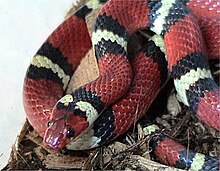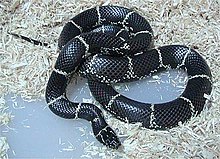
The milk snake or milksnake, is a species of kingsnake; 24 subspecies are currently recognized. Lampropeltis elapsoides, the scarlet kingsnake, was formerly classified as a 25th subspecies, but is now recognized as a distinct species. The subspecies have strikingly different appearances, and many of them have their own common names. Some authorities suggest that this species could be split into several separate species. They are not venomous to humans.

The California kingsnake is a nonvenomous colubrid snake endemic to the western United States and northern Mexico, and is found in a variety of habitats. Due to ease of care and a wide range of color variations, the California kingsnake is one of the most popular snakes in captivity.

The scarlet kingsnake or scarlet milk snake is a species of kingsnake found in the southeastern and eastern portions of the United States. Like all kingsnakes, they are nonvenomous. They are found in pine flatwoods, hydric hammocks, pine savannas, mesic pine-oak forests, prairies, cultivated fields, and a variety of suburban habitats; not unusually, people find scarlet kingsnakes in their swimming pools, especially during the spring. Until recently, and for much of the 20th century, scarlet kingsnakes were considered a subspecies of the milk snake; however, Pyron and Bubrink demonstrated the phylogenetic distinction of this species and its closer relationship to the mountain kingsnakes of the southwestern United States. These largely fossorial snakes are the smallest of all the species within the genus Lampropeltis, usually ranging from 40 to 50 cm at maturity. The maximum recorded length is in Jonesboro, AR 76.2 cm (30.0 in). Hatchlings range in size from 8 to 18 cm .

The desert kingsnake is a species of kingsnake native to Texas, Arizona, and New Mexico, United States. It is not venomous, colored yellow and black. The desert kingsnake's diet consists of rodents, lizards, and smaller snakes, including rattlesnakes. They normally grow 3–4 ft long, but have been known to grow up to 6.8 ft. They are docile creatures when confronted by humans. If they do not try to escape, often they "play dead" by flipping over onto their backs and lying motionless. Some who domesticate kingsnakes, such as ranchers, do so in the hopes that the kingsnakes will feed on other snakes, which might present more of a threat. It was previously considered a subspecies of the common kingsnake. The desert kingsnake belongs to the Colubridae family, which is the largest family of snakes in the world.
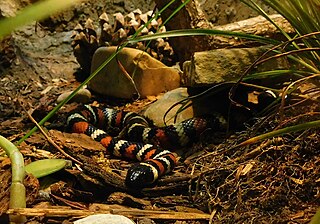
The San Diego mountain kingsnake(Lampropeltis zonata pulchra) is a subspecies of nonvenomous colubrid snake endemic to Southern California. Its state-level conservation status is "Species of Special Concern".
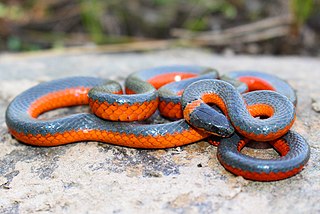
Diadophis punctatus, commonly known as the ring-necked snake or ringneck snake, is a rather small, harmless species of colubrid snake found throughout much of the United States, as well as south in Central Mexico and as far north as Quebec, Canada. Ring-necked snakes are generally fossorial and somewhat secretive, by nature, and, as a nocturnal species, are rarely seen during the daytime. These snakes are believed to be fairly abundant throughout most of their range, though no scientific evaluation supports this hypothesis. Scientific research is lacking for the species, despite their apparently common status, and more in-depth investigations are greatly needed. It is the only species within the genus Diadophis and, currently, 14 subspecies are identified, though many herpetologists question the morphologically-based classifications.

The speckled kingsnake is a species of nonvenomous kingsnake in the family Colubridae. The species is endemic to the United States.
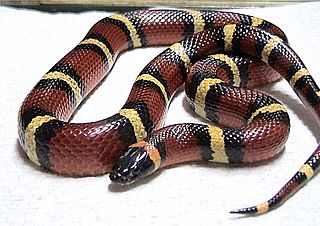
Lampropeltis annulata, commonly known as the Mexican or Tamaulipan milksnake, is a non-venomous species of milksnake. The species is native to northwestern Mexico and some adjacent United States-Mexico border regions.
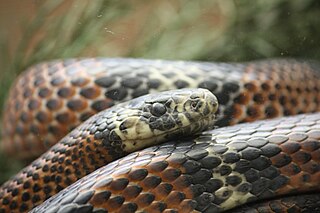
Lampropeltis triangulum andesiana, commonly known as the Andean milksnake, is an alpine subspecies of milk snake.

The Mexican black kingsnake is part of the larger colubrid family of snakes, and a subspecies of the common kingsnake, which is debated by herpetologists to contain as many as 10 unique varieties. This species occupies rocky areas and places lush with vegetation in various regions of the Sonoran Desert, Northwestern Sinaloa, Mexico, and small parts of Arizona.

Nelson's milksnake is a subspecies of king snake that is found in Mexico from southern Guanajuato and central Jalisco to the Pacific Coast. It is also found on the narrow plains of northwestern Michoacán and on the Tres Marias Islands. The range of this snake appears to be tied to the proximity of watercourses, including ones utilized for irrigation and agriculture. It is a subspecies of the milksnake, Lampropeltis triangulum. It is similar in size to other king snakes, averaging 42 inches (110 cm) long, and like them, it is nonvenomous.

Lampropeltis getula, commonly known as the eastern kingsnake, common kingsnake, or chain kingsnake, is a harmless colubrid species endemic to the United States. It has long been a favorite among collectors. Four subspecies are currently recognized, including the nominate subspecies described here. All of these taxa had originally been described as distinct species and recognized as such for up to 101 years.

The California mountain kingsnake is a species of nonvenomous colubrid snake that is endemic to North America. It is a coral snake mimic, having a similar pattern consisting of red, black, and yellow on its body, but the snake is completely harmless. Seven subspecies are recognized, with five found in the U.S., including the nominotypical subspecies, and two in Mexico.

Micruroides is a genus of venomous coral snake in the family Elapidae. The genus is monotypic, containing only the species Micruroides euryxanthus.
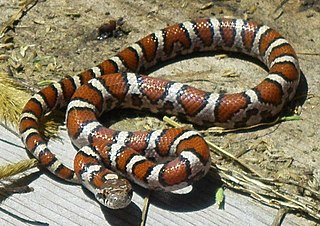
Lampropeltis triangulum triangulum, commonly known as the eastern milk snake or eastern milksnake, is a subspecies of the milk snake. The nonvenomous, colubrid snake is indigenous to eastern and central North America.

Lampropeltis mexicana, the Mexican kingsnake, is a colubrid snake that is endemic to Mexico.
